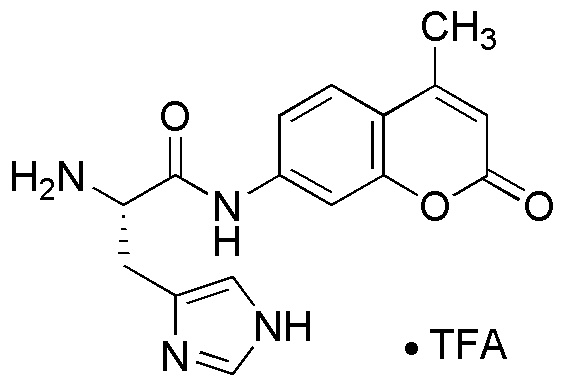L-Histidine 7-amido-4-methylcoumarin is widely utilized in research focused on:
- Biochemical Assays: This compound serves as a fluorescent probe for studying enzyme activity, particularly in protease assays, allowing researchers to visualize and quantify enzyme function in real-time.
- Drug Development: Its unique structure makes it a valuable tool in medicinal chemistry for designing new therapeutic agents, especially those targeting specific biological pathways.
- Cell Biology: The compound is used in cell culture studies to investigate cellular processes, such as apoptosis and protein synthesis, providing insights into cell behavior under various conditions.
- Diagnostics: It can be incorporated into diagnostic tests for detecting specific biomolecules, enhancing the sensitivity and specificity of assays used in clinical settings.
- Fluorescent Labeling: This chemical is applied in labeling proteins and peptides, facilitating the tracking of biomolecules in complex biological systems, which is crucial for understanding cellular mechanisms.
General Information
Properties
Safety and Regulations
Applications
L-Histidine 7-amido-4-methylcoumarin is widely utilized in research focused on:
- Biochemical Assays: This compound serves as a fluorescent probe for studying enzyme activity, particularly in protease assays, allowing researchers to visualize and quantify enzyme function in real-time.
- Drug Development: Its unique structure makes it a valuable tool in medicinal chemistry for designing new therapeutic agents, especially those targeting specific biological pathways.
- Cell Biology: The compound is used in cell culture studies to investigate cellular processes, such as apoptosis and protein synthesis, providing insights into cell behavior under various conditions.
- Diagnostics: It can be incorporated into diagnostic tests for detecting specific biomolecules, enhancing the sensitivity and specificity of assays used in clinical settings.
- Fluorescent Labeling: This chemical is applied in labeling proteins and peptides, facilitating the tracking of biomolecules in complex biological systems, which is crucial for understanding cellular mechanisms.
Documents
Safety Data Sheets (SDS)
The SDS provides comprehensive safety information on handling, storage, and disposal of the product.
Product Specification (PS)
The PS provides a comprehensive breakdown of the product’s properties, including chemical composition, physical state, purity, and storage requirements. It also details acceptable quality ranges and the product's intended applications.
Certificates of Analysis (COA)
Search for Certificates of Analysis (COA) by entering the products Lot Number. Lot and Batch Numbers can be found on a product’s label following the words ‘Lot’ or ‘Batch’.
Número de catálogo
Número de lote/lote
Certificates Of Origin (COO)
This COO confirms the country where the product was manufactured, and also details the materials and components used in it and whether it is derived from natural, synthetic, or other specific sources. This certificate may be required for customs, trade, and regulatory compliance.
Número de catálogo
Número de lote/lote
Safety Data Sheets (SDS)
The SDS provides comprehensive safety information on handling, storage, and disposal of the product.
DownloadProduct Specification (PS)
The PS provides a comprehensive breakdown of the product’s properties, including chemical composition, physical state, purity, and storage requirements. It also details acceptable quality ranges and the product's intended applications.
DownloadCertificates of Analysis (COA)
Search for Certificates of Analysis (COA) by entering the products Lot Number. Lot and Batch Numbers can be found on a product’s label following the words ‘Lot’ or ‘Batch’.
Número de catálogo
Número de lote/lote
Certificates Of Origin (COO)
This COO confirms the country where the product was manufactured, and also details the materials and components used in it and whether it is derived from natural, synthetic, or other specific sources. This certificate may be required for customs, trade, and regulatory compliance.


